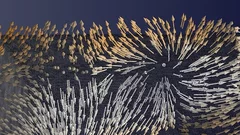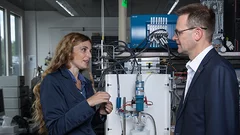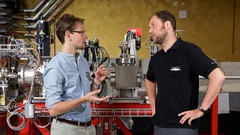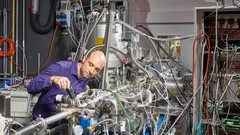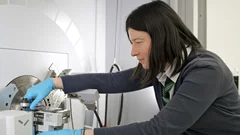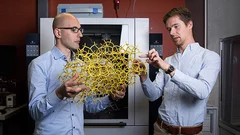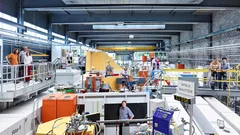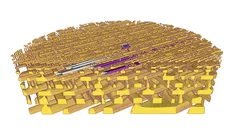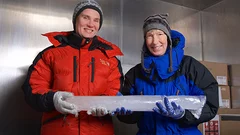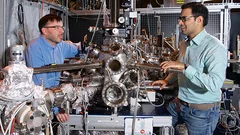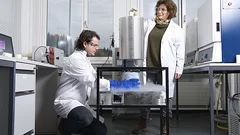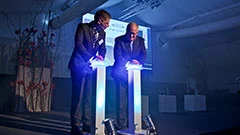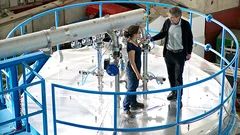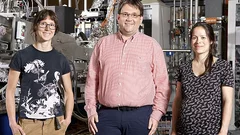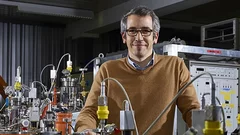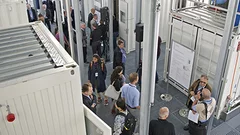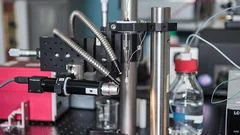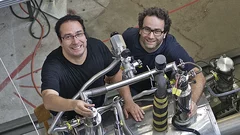Media Releases
Diving into magnets
For the first time, scientists have made visible the directions of the magnetisation inside a 3D magnetic object. The smallest details in their visualisation were ten thousand times smaller than a millimetre. Among others, the magnetic structure contained one outstanding kind of pattern: magnetic singularities called Bloch points, which up to now were only known in theory.
Nanomaterial helps store solar energy: efficiently and inexpensively
Efficient electrolysers are needed in order to store sun and wind energy in the form of hydrogen. Thanks to a new material developed by researchers at the Paul Scherrer Institute PSI and Empa, these devices are likely to become less costly and more efficient in the future. Researchers were also able to demonstrate that this new material can be reliably produced in large quantities, showing its performance capability in an electrolysis cell—the main component of an electrolyser.
Research experience from California benefits Swiss X-ray free-electron laser SwissFEL
An X-ray free-electron laser (XFEL) is capable of visualizing extremely fast structural and electronic processes. Pilot experiments will take place at the PSI's Swiss Free-Electron Laser (SwissFEL) from the end of 2017 on. Two current publications in Science and Nature Communications demonstrate the kind of outstanding scientific work that is enabled by such facilities. The work was carried out at the Linac Coherent Light Source (LCLS) in California. Two of the leading authors behind these studies have now relocated to the PSI in order to share their expertise as SwissFEL expands its capabilities.
Fuel and chemicals from plant waste
Lignin, as a constituent of many plants, accumulates in large quantities and could theoretically be used as a precursor material for production of fuels and chemicals. Researchers at the Paul Scherrer Institute PSI and ETH Zurich have developed a method with which the processes that take place in the catalytic breakdown of lignin can be observed in detail. The knowledge thus gained could enable targeted improvement of production methods in the future.
Quartz powder for the battery of the future
PSI materials researchers have developed a method that provides crucial insights into the charging and discharging processes of lithium-sulphur batteries. And the method revealed: with quartz powder added to the battery, its available energy increases and the gradual loss of capacity is much weaker.
Making a valuable resource usable with water
In oil extraction sites, gaseous methane is simply burned, even though it could actually be a useful precursor material for fuels and products of the chemical industry. One way to make methane usable is to convert it to methanol. Researchers at the Paul Scherrer Institute PSI and ETH Zurich have now developed a new chemical process that allows this conversion in an efficient and inexpensive way.
Successful for 20 years: Probing materials with particles
Whether they study materials for the electronics of the future, batteries, or swords from the Bronze Age — for 20 years researchers from a range of disciplines have been using the Swiss Spallation Neutron Source SINQ of the Paul Scherrer Institute PSI for their investigations. At a symposium on 18 April, researchers looked back on the facility's successes and presented plans for modernisation.
3-D X-ray imaging makes the finest details of a computer chip visible
Researchers at the PSI have made detailed 3-D X-ray images of a commercially available computer chip. In their experiment, they examined a small piece that they had cut out of the chip beforehand. This sample remained undamaged throughout the measurement. It is a major challenge for manufacturers to determine if, in the end, the structure of their chips conforms to the specifications. Thus these results represent one important application of an X-ray tomography method that the PSI researchers have been developing for several years.
Welcome to Esiville
A new visitor’s station at PSI tells the story of a Swiss town that makes the change from a conventional energy supply to one with new renewable energy sources.
Historical copper, trapped in ice
Until now, the onset of copper production in South America was still unclear. Hardly any written records or artefacts from the early high cultures in Peru, Chile, and Bolivia have been preserved. Now, however, researchers of the Paul Scherrer Institute PSI in Villigen (Switzerland) have tracked down the evidence. Through analysis of ice from the Illimani glacier in the Bolivian Andes, they found out that copper was being mined and smelted in South America since around 700 BC.
Nanotechnology enables new insights into chemical reactions
Eighty percent of all products of the chemical industry are manufactured with catalytic processes. Catalysis is also indispensable in energy conversion and treatment of exhaust gases. Industry is always testing new substances and arrangements that could lead to new and better catalytic processes. Researchers of the Paul Scherrer Institute PSI in Villigen and ETH Zurich have now developed a method for improving the precision of such experiments, which may speed up the search for optimal solutions.
Towards energy-saving data storage
A new material could become the basis for future data storage devices, since it may enable significant reductions in energy demands in comparison to present-day hard drives. It is a material from the class of so-called magnetoelectric multiferroics, exhibiting the necessary magnetic properties even at room temperature.
SwissFEL inauguration
Today, on 5 December 2016, the Paul Scherrer Institute PSI held an inauguration ceremony for its new large-scale research facility SwissFEL, with Johann N. Schneider-Ammann, President of the Swiss Confederation, in attendance.
The substances that brighten up the clouds
Clouds consist of tiny droplets. These droplets form when water condenses around so-called aerosols – small particles in the atmosphere. To understand how in turn aerosols come into existence scientists have now created a comprehensive computer model simulation based on profound experimental data. This simulation revealed that in addition to sulphuric acid, two other substances are crucially involved in the formation of aerosols: organic compounds and ammonia. These results have now been published in the renowned journal Science.
Selectively conductive or insulating
The material neodymium nickel oxide is either a metal or an insulator, depending on its temperature. The possibility to control this transition electrically makes the material a potential candidate for transistors in modern electronic devices. By means of a sophisticated development of X-ray scattering, researchers at the Paul Scherrer Institute PSI have now been able to track down the cause of this transition: electrons around the oxygen atoms are rearranging.
ERC funding of €2.4 million for research on fundamental interactions in magnets
Christian Rüegg has been awarded a prestigious Consolidator Grant from the European Research Council (ERC). With this funding he will continue to investigate how the smallest magnetic building blocks of matter interact.
Renewable energy: Experimental platform ESI is starting up
This fall, the time has come: The Energy System Integration Platform at the Paul Scherrer Institute PSI goes into operation. Today, in the framework of the double conference Networked Energy Research Switzerland, it was presented to the media and around 150 representatives from politics, industry, and science.
En route to better transformers
Thanks to an ultramodern research method, scientists have successfully looked inside transformers and observed the magnetic domains at work in the interior of a transformer’s iron core. Transformers are indispensable in regulating electricity both in industry and in domestic households. The current research results show that the new examination method can be profitably applied to develop more efficient transformers.
Catching proteins in the act
Proteins are indispensable building blocks of life. They play a vital role in many biological processes. Researchers have now been able to show how the ultrafast processes by which proteins do their work can be studied with free-electron X-ray lasers such as SwissFEL at the Paul Scherrer Institute PSI. Free-electron X-ray lasers generate extremely short and intense pulses of X-ray light. Currently there are just two such facilities in operation, worldwide. The results were published in the scientific journal Nature Communications.
The deuteron too poses a mystery
The deuteron — just like the proton — is smaller than previously thoughtThe deuteron — one of the simplest atomic nuclei, consisting of just one proton and one neutron — is considerably smaller than previously thought. This new research finding fits with a 2010 study in which, similarly, the proton was measured at the Paul Scherrer Institute and, likewise, a smaller value than expected was found. The result from 2010 formed the basis for what has been known since then as the proton radius puzzle.
